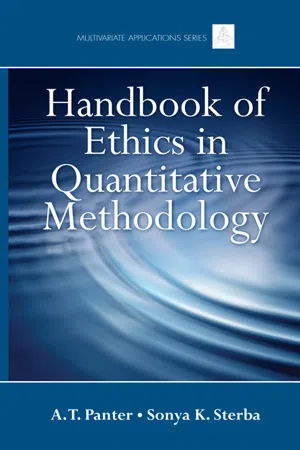
Handbook of Ethics in Quantitative Methodology
- 540 pages
- English
- ePUB (mobile friendly)
- Available on iOS & Android
Handbook of Ethics in Quantitative Methodology
About This Book
This comprehensive Handbook is the first to provide a practical, interdisciplinary review of ethical issues as they relate to quantitative methodology including how to present evidence for reliability and validity, what comprises an adequate tested population, and what constitutes scientific knowledge for eliminating biases. The book uses an ethical framework that emphasizes the human cost of quantitative decision making to help researchers understand the specific implications of their choices. The order of the Handbook chapters parallels the chronology of the research process: determining the research design and data collection; data analysis; and communicating findings. Each chapter:
- Explores the ethics of a particular topic
- Identifies prevailing methodological issues
- Reviews strategies and approaches for handling such issues and their ethical implications
- Provides one or more case examples
- Outlines plausible approaches to the issue including best-practice solutions.
Part 1 presents ethical frameworks that cross-cut design, analysis, and modeling in the behavioral sciences. Part 2 focuses on ideas for disseminating ethical training in statistics courses. Part 3 considers the ethical aspects of selecting measurement instruments and sample size planning and explores issues related to high stakes testing, the defensibility of experimental vs. quasi-experimental research designs, and ethics in program evaluation. Decision points that shape a researchers' approach to data analysis are examined in Part 4 – when and why analysts need to account for how the sample was selected, how to evaluate tradeoffs of hypothesis-testing vs. estimation, and how to handle missing data. Ethical issues that arise when using techniques such as factor analysis or multilevel modeling and when making causal inferences are also explored. The book concludes with ethical aspects of reporting meta-analyses, of cross-disciplinary statistical reform, and of the publication process.
This Handbook appeals to researchers and practitioners in psychology, human development, family studies, health, education, sociology, social work, political science, and business/marketing. This book is also a valuable supplement for quantitative methods courses required of all graduate students in these fields.
Frequently asked questions
Information
Ethics and Data Analysis Issues
Beyond Treating Complex Sampling Designs as Simple Random Samples: Data Analysis and Reporting
Random and Nonrandom Sample Selection
Reporting About Sample Selection
Methodological Guidelines
| Term | Definition | Examples |
|---|---|---|
| Sampling units | The physical units that were selected. | Persons, schools, divorce records, accident reports. |
| Sampling frame | All sampling units that had a nonzero probability of being selected into the sample. | A list of daycare centers in a community; all persons with registered university e-mail addresses; birth records from a particular county within a 2-month period. |
| Stratified sampling | Independently selecting sampling units from mutually exclusive groups, or strata, which may be preexisting or artificially defined. | Schools could be stratified into public vs. private; patients could be stratified into inpatient vs. outpatient; Alzheimer facilities could be stratified into nursing homes vs. assisted-living centers. |
| Cluster sampling | Using entire groups as sampling units, in lieu of individual elements, at one or more stages of selection. | Schools might be sampling units at a primary... |
Table of contents
- Cover Page
- Half-Title Page
- Series Title Page
- Title Page
- Copyright Page
- Dedication
- Table of Contents
- Preface
- Editors
- Contributors
- Software Notice
- Section I Developing an Ethical Framework for Methodologists
- Section II Teaching Quantitative Ethics
- Section III Ethics and Research Design Issues
- Section IV Ethics and Data Analysis Issues
- Section V Ethics and Communicating Findings
- Author Index
- Subject Index